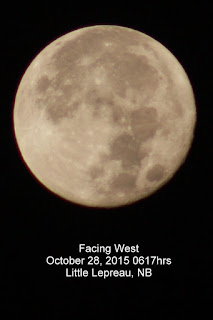Date Time: October 28, 2015 0600-0630hrs
Weather: Mostly clear with some high, thin, hazy clouds, no wind and a very cool -4C.
Attendance: David M.
Equipment: Canon Rebel Xsi Camera on tripod with 18-55mm and 75-300mm lenses.
Objective: To view and image Mars Venus Jupiter Conjunction which was suppose to be in the East on this morning.
Highlights:
- Very cool out, lots of frost on everything.
- A very bright Moon that was one day past full washed out most stars, but Leo in the East, Ursa Major in the North East and Orion in the South West stood out nicely, but much fainter than normal.
- Sirius, the brightest star that can be seen from New Brunswick was observed in the South.
- Conjunction formed a tight group just below Leo.
- Vindemiatrix (Epsilon Virginis) was spotted rising just before first light. This is interesting because in between this star and Denebola (Beta Leo) is the Virgo Cluster of Galaxies...which is a Spring time target for Amateur Astronomers.
- Towards the end of the observing session, a Lunar Corona formed around the Moon.
- No Shooting stars and no satellites were seen.
Images:
| Close-up of Jupiter(upper right), Venus (center right), Mars(very bottom left) |
 |
| Lunar Corona formed at around 0620hrs. |




















